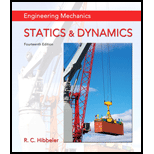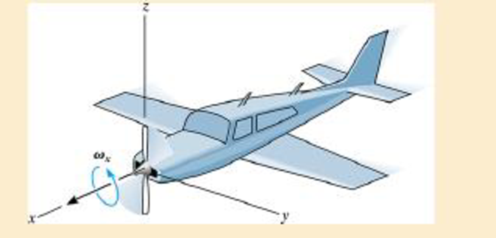
Engineering Mechanics: Statics & Dynamics (14th Edition)
14th Edition
ISBN: 9780133915426
Author: Russell C. Hibbeler
Publisher: PEARSON
expand_more
expand_more
format_list_bulleted
Concept explainers
Textbook Question
Chapter 20.3, Problem 1P
The propeller of an airplane is rotating at a constant speed ωxi, while the plane is undergoing a turn at a constant rate ωt. Determine the angular acceleration of the propeller. If (a) the turn is horizontal, i.e., ωt k, and (b) the turn is vertical, downward, i.e., ωt j.

Prob. 20-1
Expert Solution & Answer
Want to see the full answer?
Check out a sample textbook solution
Students have asked these similar questions
using the theorem of three moments, find all the moments, I need concise calculations only
Practise question need help on
Can you show explaination and working. The answer from the text book is Q=5.03 X 10^-3
Chapter 20 Solutions
Engineering Mechanics: Statics & Dynamics (14th Edition)
Ch. 20.3 - The propeller of an airplane is rotating at a...Ch. 20.3 - The disk rotates about the z axis at a constant...Ch. 20.3 - The ladder of the fire truck rotates around the z...Ch. 20.3 - The ladder of the fire truck rotates around the z...Ch. 20.3 - Prob. 5PCh. 20.3 - The conical spool rolls on the plane without...Ch. 20.3 - At a given instant, the antenna has an angular...Ch. 20.3 - The disk rotates about the shaft S, while the...Ch. 20.3 - The electric fan is mounted on a swivel support...Ch. 20.3 - The electric fan is mounted on a swivel support...
Ch. 20.3 - Prob. 12PCh. 20.3 - Prob. 13PCh. 20.3 - The wheel is spinning about shaft AB with an...Ch. 20.3 - Prob. 15PCh. 20.3 - Prob. 16PCh. 20.3 - The truncated double cone rotates about the z axis...Ch. 20.3 - Gear A is fixed to the crankshaft S, while gear C...Ch. 20.3 - Prob. 20PCh. 20.3 - Gear B is driven by a motor mounted on turntable...Ch. 20.3 - Prob. 22PCh. 20.3 - Prob. 23PCh. 20.3 - Prob. 24PCh. 20.3 - Disk A rotates at a constant angular velocity of...Ch. 20.3 - Prob. 26PCh. 20.3 - Prob. 27PCh. 20.3 - Prob. 28PCh. 20.3 - Prob. 29PCh. 20.3 - Prob. 30PCh. 20.3 - Prob. 31PCh. 20.3 - Prob. 32PCh. 20.3 - Prob. 33PCh. 20.3 - Prob. 34PCh. 20.3 - Prob. 35PCh. 20.3 - Prob. 36PCh. 20.4 - So1ve Example 20.5 such that the x, y, z axes move...Ch. 20.4 - Prob. 38PCh. 20.4 - At the instant = 60, the telescopic boom AB of...Ch. 20.4 - Prob. 40PCh. 20.4 - At the instant shown, the arm AB is rotating about...Ch. 20.4 - Prob. 42PCh. 20.4 - Prob. 43PCh. 20.4 - Prob. 44PCh. 20.4 - Prob. 45PCh. 20.4 - Prob. 46PCh. 20.4 - Prob. 47PCh. 20.4 - Prob. 48PCh. 20.4 - Prob. 49PCh. 20.4 - Prob. 50PCh. 20.4 - Prob. 51PCh. 20.4 - Prob. 52PCh. 20.4 - Prob. 53PCh. 20.4 - Prob. 54P
Knowledge Booster
Learn more about
Need a deep-dive on the concept behind this application? Look no further. Learn more about this topic, mechanical-engineering and related others by exploring similar questions and additional content below.Similar questions
- practise questionarrow_forwardCan you provide steps and an explaination on how the height value to calculate the Pressure at point B is (-5-3.5) and the solution is 86.4kPa.arrow_forwardPROBLEM 3.46 The solid cylindrical rod BC of length L = 600 mm is attached to the rigid lever AB of length a = 380 mm and to the support at C. When a 500 N force P is applied at A, design specifications require that the displacement of A not exceed 25 mm when a 500 N force P is applied at A For the material indicated determine the required diameter of the rod. Aluminium: Tall = 65 MPa, G = 27 GPa. Aarrow_forward
- Find the equivalent mass of the rocker arm assembly with respect to the x coordinate. k₁ mi m2 k₁arrow_forward2. Figure below shows a U-tube manometer open at both ends and containing a column of liquid mercury of length l and specific weight y. Considering a small displacement x of the manometer meniscus from its equilibrium position (or datum), determine the equivalent spring constant associated with the restoring force. Datum Area, Aarrow_forward1. The consequences of a head-on collision of two automobiles can be studied by considering the impact of the automobile on a barrier, as shown in figure below. Construct a mathematical model (i.e., draw the diagram) by considering the masses of the automobile body, engine, transmission, and suspension and the elasticity of the bumpers, radiator, sheet metal body, driveline, and engine mounts.arrow_forward
- 3.) 15.40 – Collar B moves up at constant velocity vB = 1.5 m/s. Rod AB has length = 1.2 m. The incline is at angle = 25°. Compute an expression for the angular velocity of rod AB, ė and the velocity of end A of the rod (✓✓) as a function of v₂,1,0,0. Then compute numerical answers for ȧ & y_ with 0 = 50°.arrow_forward2.) 15.12 The assembly shown consists of the straight rod ABC which passes through and is welded to the grectangular plate DEFH. The assembly rotates about the axis AC with a constant angular velocity of 9 rad/s. Knowing that the motion when viewed from C is counterclockwise, determine the velocity and acceleration of corner F.arrow_forward500 Q3: The attachment shown in Fig.3 is made of 1040 HR. The static force is 30 kN. Specify the weldment (give the pattern, electrode number, type of weld, length of weld, and leg size). Fig. 3 All dimension in mm 30 kN 100 (10 Marks)arrow_forward
- (read image) (answer given)arrow_forwardA cylinder and a disk are used as pulleys, as shown in the figure. Using the data given in the figure, if a body of mass m = 3 kg is released from rest after falling a height h 1.5 m, find: a) The velocity of the body. b) The angular velocity of the disk. c) The number of revolutions the cylinder has made. T₁ F Rd = 0.2 m md = 2 kg T T₂1 Rc = 0.4 m mc = 5 kg ☐ m = 3 kgarrow_forward(read image) (answer given)arrow_forward
arrow_back_ios
SEE MORE QUESTIONS
arrow_forward_ios
Recommended textbooks for you
 Elements Of ElectromagneticsMechanical EngineeringISBN:9780190698614Author:Sadiku, Matthew N. O.Publisher:Oxford University Press
Elements Of ElectromagneticsMechanical EngineeringISBN:9780190698614Author:Sadiku, Matthew N. O.Publisher:Oxford University Press Mechanics of Materials (10th Edition)Mechanical EngineeringISBN:9780134319650Author:Russell C. HibbelerPublisher:PEARSON
Mechanics of Materials (10th Edition)Mechanical EngineeringISBN:9780134319650Author:Russell C. HibbelerPublisher:PEARSON Thermodynamics: An Engineering ApproachMechanical EngineeringISBN:9781259822674Author:Yunus A. Cengel Dr., Michael A. BolesPublisher:McGraw-Hill Education
Thermodynamics: An Engineering ApproachMechanical EngineeringISBN:9781259822674Author:Yunus A. Cengel Dr., Michael A. BolesPublisher:McGraw-Hill Education Control Systems EngineeringMechanical EngineeringISBN:9781118170519Author:Norman S. NisePublisher:WILEY
Control Systems EngineeringMechanical EngineeringISBN:9781118170519Author:Norman S. NisePublisher:WILEY Mechanics of Materials (MindTap Course List)Mechanical EngineeringISBN:9781337093347Author:Barry J. Goodno, James M. GerePublisher:Cengage Learning
Mechanics of Materials (MindTap Course List)Mechanical EngineeringISBN:9781337093347Author:Barry J. Goodno, James M. GerePublisher:Cengage Learning Engineering Mechanics: StaticsMechanical EngineeringISBN:9781118807330Author:James L. Meriam, L. G. Kraige, J. N. BoltonPublisher:WILEY
Engineering Mechanics: StaticsMechanical EngineeringISBN:9781118807330Author:James L. Meriam, L. G. Kraige, J. N. BoltonPublisher:WILEY

Elements Of Electromagnetics
Mechanical Engineering
ISBN:9780190698614
Author:Sadiku, Matthew N. O.
Publisher:Oxford University Press

Mechanics of Materials (10th Edition)
Mechanical Engineering
ISBN:9780134319650
Author:Russell C. Hibbeler
Publisher:PEARSON

Thermodynamics: An Engineering Approach
Mechanical Engineering
ISBN:9781259822674
Author:Yunus A. Cengel Dr., Michael A. Boles
Publisher:McGraw-Hill Education

Control Systems Engineering
Mechanical Engineering
ISBN:9781118170519
Author:Norman S. Nise
Publisher:WILEY

Mechanics of Materials (MindTap Course List)
Mechanical Engineering
ISBN:9781337093347
Author:Barry J. Goodno, James M. Gere
Publisher:Cengage Learning

Engineering Mechanics: Statics
Mechanical Engineering
ISBN:9781118807330
Author:James L. Meriam, L. G. Kraige, J. N. Bolton
Publisher:WILEY
Dynamics - Lesson 1: Introduction and Constant Acceleration Equations; Author: Jeff Hanson;https://www.youtube.com/watch?v=7aMiZ3b0Ieg;License: Standard YouTube License, CC-BY